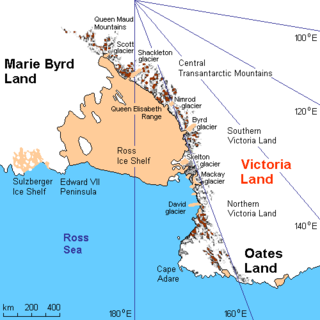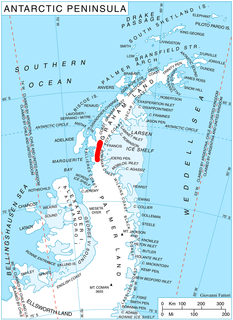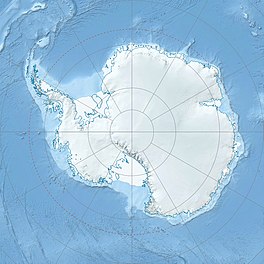The Queen Elizabeth Range is a rugged mountain range of the Transantarctic Mountains System, located in the Ross Dependency region of Antarctica.

Skelton Glacier is a large glacier flowing from the polar plateau into the Ross Ice Shelf at Skelton Inlet on the Hillary Coast, south of Victoria Land, Antarctica.

The Usarp Mountains are a major Antarctic mountain range, lying west of the Rennick Glacier and trending north to south for about 190 kilometres (118 mi). The feature is bounded to the north by Pryor Glacier and the Wilson Hills.
Wilson Hills is a group of scattered hills, nunataks and ridges that extend NW-SE for about 110 kilometres (68 mi) between Matusevich Glacier and Pryor Glacier in Antarctica. They were discovered by Lieutenant Harry Pennell, Royal Navy, on the Terra Nova Expedition in February 1911 during Robert Falcon Scott's last expedition, and named after Dr. Edward A. Wilson, a zoologist with the expedition, who perished with Scott on the return journey from the South Pole.

Chamberlin Glacier is a glacier on the east side of Hemimont Plateau which flows northeast into Whirlwind Inlet about 4 nautical miles (7 km) southeast of Matthes Glacier, on the east coast of Graham Land.
Colwell Massif is a rugged rock massif, about 4 nautical miles (7 km) long, rising to 2,635 metres (8,650 ft) between Palais Glacier, Ferrar Glacier, and Rotunda Glacier, in Victoria Land. It was named by the Advisory Committee on Antarctic Names in 1994 after Rita R. Colwell, marine microbiologist who has conducted field research in Antarctica; member of National Science Board (1983–90) who chaired Presidential committee on National Science Foundation roles in the polar regions; from 1991, President, Maryland Biotechnology Institute, University of Maryland.
Walsh Glacier is a tributary glacier in the central part of Wilson Hills. It drains east-northeast along the south side of Goodman Hills to enter the lower part of Tomilin Glacier. Mapped by United States Geological Survey (USGS) from surveys and U.S. Navy air photos, 1960–64. Named by Advisory Committee on Antarctic Names (US-ACAN) for Gary Walsh, United States Antarctic Research Program (USARP) biologist at Hallett Station, 1968–69.
Warren Range is an Antarctic mountain range about 15 nautical miles (28 km) long just west of Boomerang Range, with which it lies parallel, in Oates Land. Discovered by the Northern Survey Party of the Commonwealth Trans-Antarctic Expedition (1956–58), which called the highest summit "Mount Warren" after Guyon Warren, a member of the party in 1957–58. To avoid confusion with another mountain of the same name, the name Warren has instead been applied to the whole range.
Crume Glacier is a tributary glacier, 5 nautical miles (9 km) long, flowing east to enter Ommanney Glacier near the north coast of Victoria Land, Antarctica. The geographical feature was first mapped by the United States Geological Survey from surveys and from U.S. Navy air photos, 1960–63, and named by the Advisory Committee on Antarctic Names for William R. Crume, AS1, U.S. Navy, Support Equipment Maintenance Supervisor with Squadron VX-6 at McMurdo Station, Hut Point Peninsula, Ross Island, during Operation Deep Freeze 1968. The glacier lies situated on the Pennell Coast, a portion of Antarctica lying between Cape Williams and Cape Adare.
Mount Guyon is a bluff-type mountain with a small summit area, 2,541 metres (8,337 ft) high. It rises at the west side of Deception Glacier and forms the highest elevation in the Warren Range in Antarctica. The Northern Party of the Commonwealth Trans-Antarctic Expedition (1956–58) called this feature "Mount Warren" after Guyon Warren, a member of the field party in 1957–58. That name was not adopted in order to avoid confusion with another Mount Warren, so the name Mount Guyon was approved in keeping with the spirit of the original naming.

Mount Mohl is a mountain, 3,710 metres (12,170 ft) high, at the east side of Vinson Massif, surmounting the ridge between the heads of Dater Glacier and Thomas Glacier, in the Sentinel Range of the Ellsworth Mountains, Antarctica. It is connected to Doyran Heights to the northeast by Goreme Col.

Français Glacier is a glacier 4 nautical miles (7 km) wide and 12 nautical miles (22 km) long, flowing north-northeast from the continental ice to the Antarctic coast close west of Ravin Bay. Though no glaciers were noted on Captain Jules Dumont d'Urville's chart of this coast, the close correlation of his "Baie des Ravins" feature and narrative description with the indentation of the coast near the mouth of this glacier suggests first sighting of this feature by the French Antarctic Expedition, 1837–40. During December 1912 members of the Main Base Party of the Australasian Antarctic Expedition (AAE) camped on the upland slopes close east of the glacier, but no reference was made to the glacier in the AAE reports, though a clear view and unpublished sketch were obtained of the distant coast to the northwest.
Haines Glacier is a glacier 4 nautical miles (7 km) wide, flowing in a southeasterly direction and joining Meinardus Glacier immediately east of Mount Barkow, on the east coast of Palmer Land, Antarctica. It was discovered and photographed from the air in December 1940 by the United States Antarctic Service. During 1947 the glacier was photographed from the air by the Ronne Antarctic Research Expedition, who in conjunction with the Falkland Islands Dependencies Survey (FIDS) charted it from the ground. The glacier was named by the FIDS for William C. Haines, an American meteorologist who was a member of the Byrd Antarctic Expeditions of 1928–30 and 1933–35, and was joint author of the meteorological reports of these two expeditions.

Hale Glacier is a glacier about 6 nautical miles (11 km) long, located just east of Mount Simpson on Thurston Island, Antarctica, and flowing southwest to the Abbot Ice Shelf in Peacock Sound. It was delineated from air photos taken by U.S. Navy Squadron VX-6 in January 1960, and was named by the Advisory Committee on Antarctic Names (US-ACAN) for Lieutenant Bill J. Hale, U.S. Navy, a helicopter pilot aboard USS Burton Island who made exploratory flights to Thurston Island in February 1960.
Haley Glacier is a glacier, 8 nautical miles (15 km) long, draining southeast along the north side of Rowley Massif into Odom Inlet, on the east coast of Palmer Land, Antarctica. It was mapped by United States Geological Survey in 1974, and was named by the Advisory Committee on Antarctic Names for Philip H. Haley, a United States Antarctic Research Program biologist at Palmer Station, 1973.

Hansen Glacier is a tributary glacier 10 nautical miles long, flowing northeast from Mount Tuck between Veregava Ridge and Doyran Heights to join Dater Glacier west of Dickey Peak, in the Sentinel Range of the Ellsworth Mountains in Antarctica.
Heidemann Glacier is a glacier, 5 nautical miles (9 km) long, originating close northwest of Mount Damm in the Queen Elizabeth Range of Antarctica and flowing east into Lowery Glacier. It was mapped by the United States Geological Survey from tellurometer surveys and Navy air photos, 1960–62, and was named by the Advisory Committee on Antarctic Names for Richard P. Heidemann, a United States Antarctic Research Program glaciologist at Roosevelt Island, 1962–63.

Hudman Glacier is a glacier draining south of Mount Landolt between Marze Peak and Miller Peak in Petvar Heights at the south end of the Sentinel Range, in the Ellsworth Mountains of Antarctica, flowing south-southeast to Minnesota Glacier. It was mapped by the United States Geological Survey from surveys and U.S. Navy air photos, 1957–59, and was named by the Advisory Committee on Antarctic Names for Captain Rayburn A. Hudman, United States Marine Corps, who died in the crash of a Lockheed P2V-2n Neptune, modified for extreme range, flying in sub zero temperatures and Ski equippedfor landing on the Ice runways at McMurdo Sound Antarctica on October 18, 1956.

Horton Glacier is a glacier at the east side of Mount Barre and Mount Gaudry, flowing southeast from Adelaide Island into Ryder Bay, Antarctica. It was named by the UK Antarctic Place-Names Committee in 1977 for Colin P. Horton, a British Antarctic Survey builder at the nearby Rothera Station, 1976–77.
Mount Ritchie is a mountain rising over 1600 m in the southeast part of Warren Range, Antarctica. The feature is 3 nautical miles (6 km) northeast of Wise Peak on the west side of Deception Glacier. Named by the Victoria University of Wellington Antarctic Expedition (VUWAE), 1970–71, after A. Ritchie, curator of fossils at the Australian Museum, Sydney, a member of the VUWAE party that discovered important sites of fossil fish in this Skelton Neve area.







